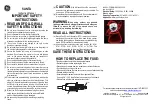
- 24 -
PEAK
By keeping the PEAK input closed the maximum weight value reached remains displayed. By
opening the input the current weight is displayed.
If you wish to use this input to view a sudden variation peak, set the FILTER ON THE
WEIGHT to 0.
ANALOG OUTPUT
-
: it selects the analog output type (4÷20 mA, 0÷20 mA, 0÷10 V, 0÷5 V,
±
10 V,
±
5 V;
default: 4÷20 mA).
-
: choice of a weight followed by the analog output: gross (
) or net (
). If the net
function is not active, the analog output varies according to gross weight.
-
: set the weight value for which you wish to obtain the minimum analog output value.
Only set a value different from zero if you wish to limit the analog output range; for
instance: for a full scale value of 10000 kg you require an 4 mA signal at 5000 kg and
20 mA at 10000 kg, in this case, instead of zero, set 5000 kg.
-
: set the weight value for which you wish to obtain the maximum analog output value; it
must correspond to the value set in the PLC program (default: calibration full scale). E.g.: if I am
using a 4÷20 mA output and in the PLC program I wish to have 20 mA = 8000 kg, I will set the
parameter to 8000.
-
: analog output correction to zero: if necessary adjust the analog output, allowing the PLC
to indicate 0. The sign - can be set for the last digit on the left. E.g.: if I use a 4÷20 mA output
and, with the minimum analog setting, the PLC or tester read 4.1 mA, I must set the parameter to
3.9 to obtain 4.0 on the PLC or tester.
-
: correction of analog output to full scale: if necessary permit modification of the analog
output by allowing PLC to indicate the value set in the parameter
. E.g. if I am using a
4÷20 mA output with the analog set to full scale and the PLC or tester reads 19.9 mA, I must set
the parameter to 20.1 to get 20.0 on the PLC or tester.
+
















































